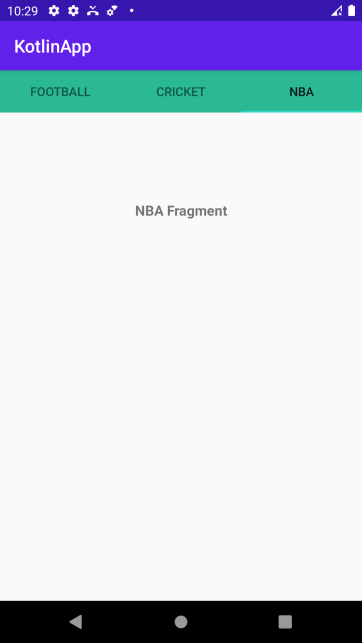
 Data Structure
Data Structure Networking
Networking RDBMS
RDBMS Operating System
Operating System Java
Java MS Excel
MS Excel iOS
iOS HTML
HTML CSS
CSS Android
Android Python
Python C Programming
C Programming C++
C++ C#
C# MongoDB
MongoDB MySQL
MySQL Javascript
Javascript PHP
PHP
- Selected Reading
- UPSC IAS Exams Notes
- Developer's Best Practices
- Questions and Answers
- Effective Resume Writing
- HR Interview Questions
- Computer Glossary
- Who is Who
How to create Tab Layout in an Android App using Kotlin?
This example demonstrates how to create Tab Layout in an Android App using Kotlin.
Step 1 − Create a new project in Android Studio, go to File? New Project and fill all required details to create a new project.
Step 2 − Add the following code to res/layout/activity_main.xml.
Example
<?xml version="1.0" encoding="utf-8"?> <RelativeLayout xmlns:android="http://schemas.android.com/apk/res/android" xmlns:tools="http://schemas.android.com/tools" android:layout_width="match_parent" android:layout_height="match_parent" tools:context=".MainActivity"> <com.google.android.material.tabs.TabLayout android:id="@+id/tabLayout" android:layout_width="match_parent" android:layout_height="wrap_content" android:background="#1db995"> </com.google.android.material.tabs.TabLayout> <androidx.viewpager.widget.ViewPager android:id="@+id/viewPager" android:layout_width="wrap_content" android:layout_height="wrap_content" android:layout_below="@id/tabLayout" android:layout_centerInParent="true" android:layout_marginTop="100dp" tools:layout_editor_absoluteX="8dp" /> </RelativeLayout>
Step 3 − Add the following code to src/MainActivity.kt
import android.os.Bundle
import androidx.appcompat.app.AppCompatActivity
import androidx.viewpager.widget.ViewPager
import com.google.android.material.tabs.TabLayout
import com.google.android.material.tabs.TabLayout.OnTabSelectedListener
import com.google.android.material.tabs.TabLayout.TabLayoutOnPageChangeListener
class MainActivity : AppCompatActivity() {
lateinit var tabLayout: TabLayout
lateinit var viewPager: ViewPager
override fun onCreate(savedInstanceState: Bundle?) {
super.onCreate(savedInstanceState)
setContentView(R.layout.activity_main)
title = "KotlinApp"
tabLayout = findViewById(R.id.tabLayout)
viewPager = findViewById(R.id.viewPager)
tabLayout.addTab(tabLayout.newTab().setText("Football"))
tabLayout.addTab(tabLayout.newTab().setText("Cricket"))
tabLayout.addTab(tabLayout.newTab().setText("NBA"))
tabLayout.tabGravity = TabLayout.GRAVITY_FILL
val adapter = MyAdapter(this, supportFragmentManager,
tabLayout.tabCount)
viewPager.adapter = adapter
viewPager.addOnPageChangeListener(TabLayoutOnPageChangeListener(tabLayout))
tabLayout.addOnTabSelectedListener(object : OnTabSelectedListener {
override fun onTabSelected(tab: TabLayout.Tab) {
viewPager.currentItem = tab.position
}
override fun onTabUnselected(tab: TabLayout.Tab) {}
override fun onTabReselected(tab: TabLayout.Tab) {}
})
}
}
Step 4 − Create a new Adapter kotlin class (MyAdapter.kt) and add the following code −
import android.content.Context
import androidx.fragment.app.Fragment
import androidx.fragment.app.FragmentManager
import androidx.fragment.app.FragmentPagerAdapter
@Suppress("DEPRECATION")
internal class MyAdapter(
var context: Context,
fm: FragmentManager,
var totalTabs: Int
) :
FragmentPagerAdapter(fm) {
override fun getItem(position: Int): Fragment {
return when (position) {
0 -> {
Football()
}
1 -> {
Cricket()
}
2 -> {
NBA()
}
else -> getItem(position)
}
}
override fun getCount(): Int {
return totalTabs
}
}
Step 5 − Create 3 Fragment activities (Cricket, Football, NBA - You can have your name) and the following code −
Cricket.kt
import android.os.Bundle
import android.view.LayoutInflater
import android.view.View
import android.view.ViewGroup
import androidx.fragment.app.Fragment
class Cricket : Fragment() {
override fun onCreateView(
inflater: LayoutInflater, container: ViewGroup?,
savedInstanceState: Bundle?
): View? {
// Inflate the layout for this fragment
return inflater.inflate(R.layout.fragment_cricket, container, false)
}
}
fragment_cricket.xml
<?xml version="1.0" encoding="utf-8"?> <FrameLayout xmlns:android="http://schemas.android.com/apk/res/android" xmlns:tools="http://schemas.android.com/tools" android:layout_width="match_parent" android:layout_height="match_parent" tools:context=".Cricket"> <!-- TODO: Update blank fragment layout --> <TextView android:layout_width="match_parent" android:layout_height="match_parent" android:text="Cricket Fragment" android:textAlignment="center" android:textSize="16sp" android:textStyle="bold" /> </FrameLayout>
Football.kt
import android.os.Bundle
import android.view.LayoutInflater
import android.view.View
import android.view.ViewGroup
import androidx.fragment.app.Fragment
class Football : Fragment() {
override fun onCreateView(
inflater: LayoutInflater, container: ViewGroup?,
savedInstanceState: Bundle?
): View? {
// Inflate the layout for this fragment
return inflater.inflate(R.layout.fragment_football, container, false)
}
}
fragment_footbal.xml
<?xml version="1.0" encoding="utf-8"?> <FrameLayout xmlns:android="http://schemas.android.com/apk/res/android" xmlns:tools="http://schemas.android.com/tools" android:layout_width="match_parent" android:layout_height="match_parent" tools:context=".Football"> <!-- TODO: Update blank fragment layout --> <TextView android:layout_width="match_parent" android:layout_height="match_parent" android:text="Football Fragment" android:textAlignment="center" android:textSize="16sp" android:textStyle="bold" /> </FrameLayout>
NBA.kt
import android.os.Bundle
import androidx.fragment.app.Fragment
import android.view.LayoutInflater
import android.view.View
import android.view.ViewGroup
class NBA : Fragment() {
override fun onCreateView(
inflater: LayoutInflater, container: ViewGroup?,
savedInstanceState: Bundle?
): View? {
// Inflate the layout for this fragment
return inflater.inflate(R.layout.fragment_n_b_a, container, false)
}
}
fragment_n_b_a.xml
<?xml version="1.0" encoding="utf-8"?> <FrameLayout xmlns:android="http://schemas.android.com/apk/res/android" xmlns:tools="http://schemas.android.com/tools" android:layout_width="match_parent" android:layout_height="match_parent" tools:context=".NBA"> <!-- TODO: Update blank fragment layout --> <TextView android:layout_width="match_parent" android:layout_height="match_parent" android:text="NBA Fragment" android:textAlignment="center" android:textSize="16sp" android:textStyle="bold" /> </FrameLayout>
Step 6 − Add the following code to androidManifest.xml
<?xml version="1.0" encoding="utf-8"?> <manifest xmlns:android="http://schemas.android.com/apk/res/android" package="com.example.q11"> <application android:allowBackup="true" android:icon="@mipmap/ic_launcher" android:label="@string/app_name" android:roundIcon="@mipmap/ic_launcher_round" android:supportsRtl="true" android:theme="@style/AppTheme"> <activity android:name=".MainActivity"> <intent-filter> <action android:name="android.intent.action.MAIN" /> <category android:name="android.intent.category.LAUNCHER" /> </intent-filter> </activity> </application> </manifest>
Let's try to run your application. I assume you have connected your actual Android Mobile device with your computer. To run the app from android studio, open one of your project's activity files and click the Run icon![]() from the toolbar. Select your mobile device as an option and then check your mobile device which will display your default screen
from the toolbar. Select your mobile device as an option and then check your mobile device which will display your default screen




